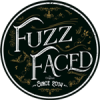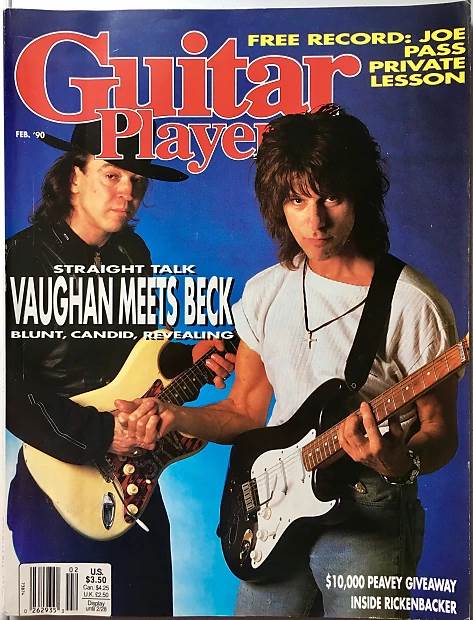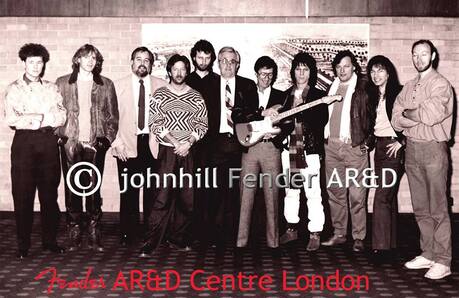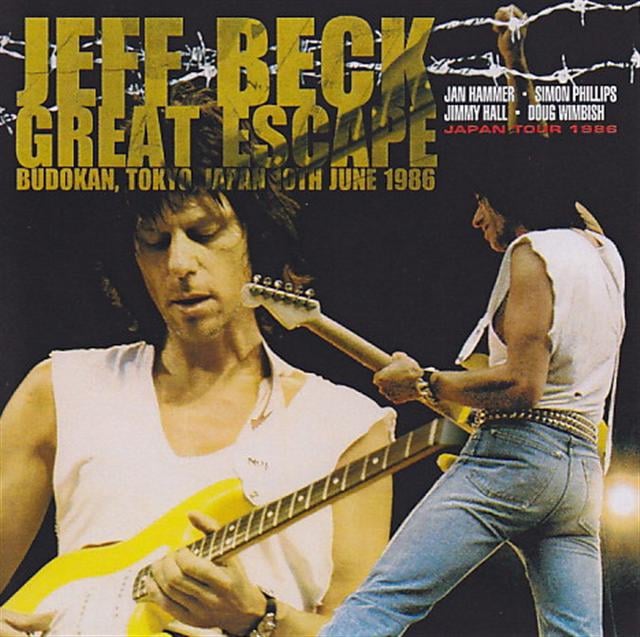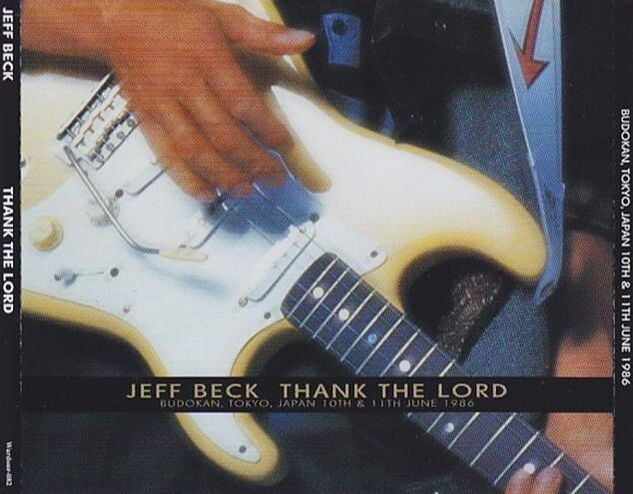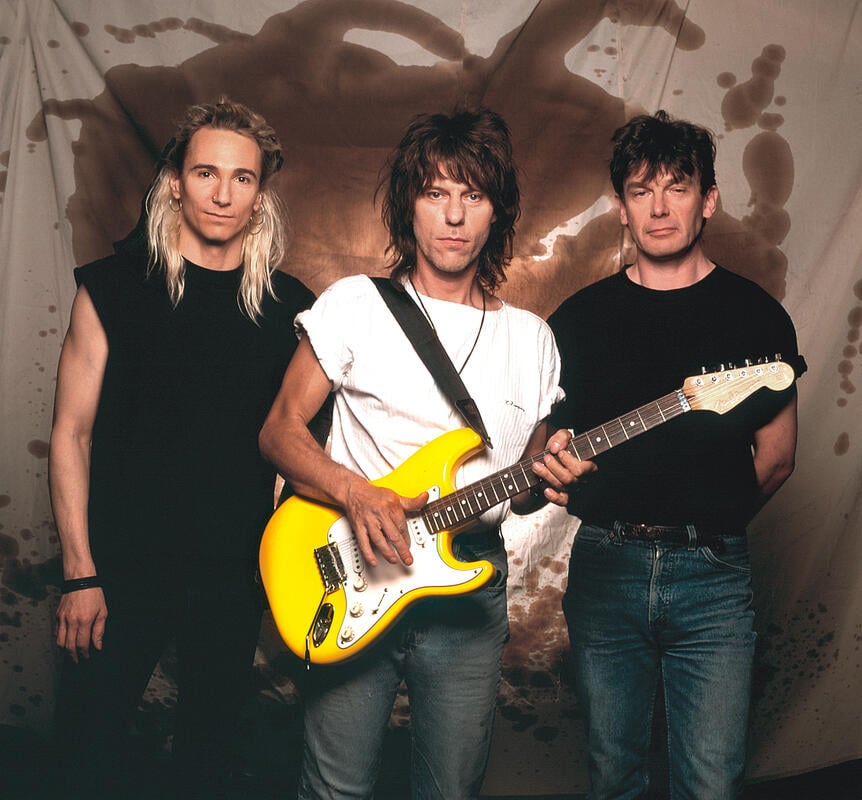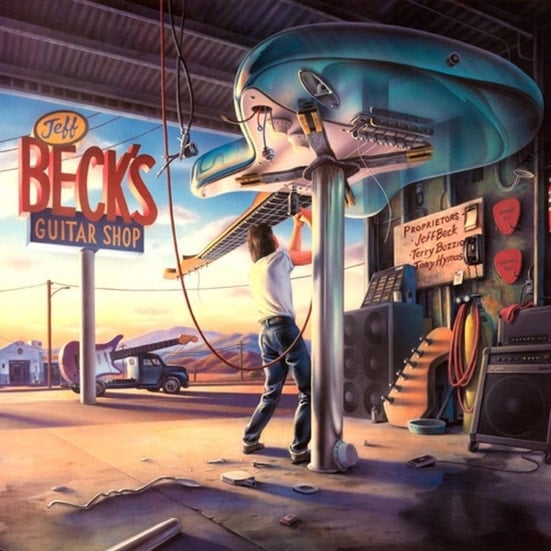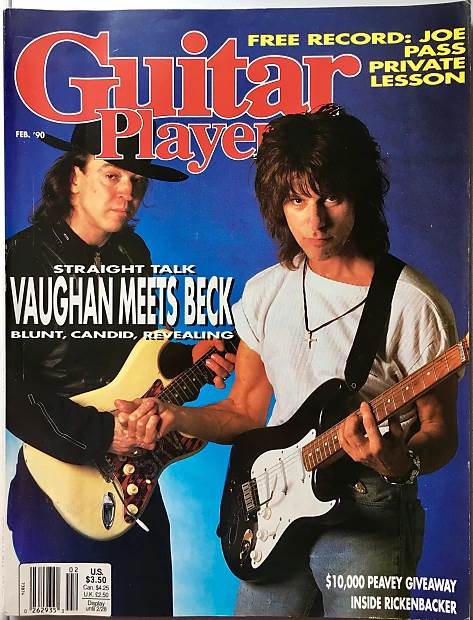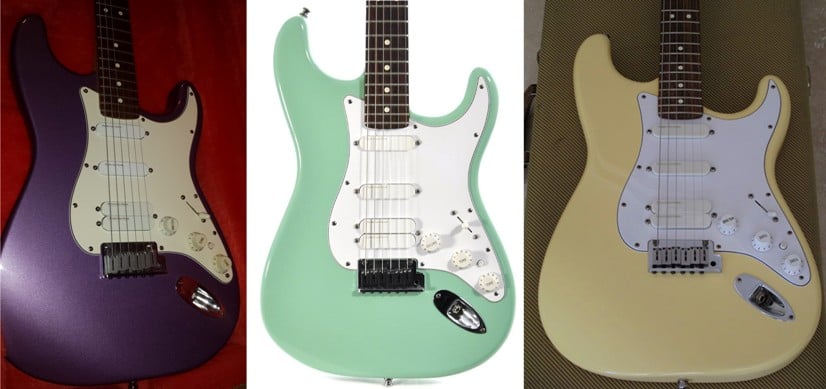The Jeff Beck's Graffiti Yellow Strat and the Origin Of The signature
|
On February 12, 1986, John Hill, Fender’s Brand and Artist Relations Director, organized a party in a Hilton Hotel in London to celebrate the first Stratocaster that came to the UK, the Fiesta Red Strat of the Shadows guitarist, Hank Marvin. The aim of John was to change perceptions about Fender with the help of a group of the most important guitarists in the world (that he called “britpack”) by getting them all onboard as part of a relaunch and rebrand of Fender.
Eric Clapton, David Gilmour, Hank Marvin, and Jeff Beck were just some of those that attended, with John Hill in the background and of course Bill Schultz and Dan Smith. This was the first occasion for Smith and Schultz to discuss the Signature Series with the guests. |
A few months after the event, Jeff asked for a new Stratocaster with a huge neck for his upcoming tour in Japan.
As John Hill knew of Jeff's passion for the 1932 Ford Chopped Deuce Coupe featured in the American Graffiti movie, he suggested painting the guitar in the color of the car that he named Graffiti Yellow. So, it wasn't a request of the guitarist, as is often reported.
As John Hill knew of Jeff's passion for the 1932 Ford Chopped Deuce Coupe featured in the American Graffiti movie, he suggested painting the guitar in the color of the car that he named Graffiti Yellow. So, it wasn't a request of the guitarist, as is often reported.
|
Many guitars were made by a select group at Fender and Jeff ended up taking a yellow Vintage '62 Strat serial number V016129 stamped on the neck plate. At this time the guitar was fitted with a vintage-style bridge, a 3-ply white 11-hole pickguard, and vintage reissue pickups, but not the Wilkinson Roller Nut. Its oversized raw wood neck was left unfinished in order to get the profile Jeff wanted, but the guitarist wanted it just as it was, as told by Dan Smith: “We took it into a rehearsal, and he [Jeff, Editor’s Note] liked it so much he insisted to take it on tour to Japan as is, and [with the back of the neck, Editor’s Note] unfinished.”
|
The vintage-style bridge and the original nut can be seen clearly on the cover of the CDs associated with the Japanese tour.
After the tour in Japan in the Summer of 1986, the guitar was returned to Fender and was subject to some important modifications. The vintage-style bridge was removed and replaced with a very rough proto of the two-pivot tremolo that they pulled off of the American Standard prototype, a new oversized neck with a Brazilian rosewood fingerboard was installed, and the 3-ply 11-hole pickguard was replaced with a 3-ply 8-hole one.
|
The neck featured a headstock with then-still-in-development Sperzel Star locking tuners and the first-generation Trevor Wilkinson’s roller nut, enhancing its tuning stability and playability. “Feels like an early Stratocaster, but without the tuning problems,” Jeff stated.
Lace Sensors were in development at this time, they were not quite ready yet and so it may have been that the guitar kept its ‘60s pickups, even though George Blanda declared that the guitar was equipped with three stacked-coil pickups. This new combination later evolved into the factory’s upscale Strat Plus, introduced in 1987. The guitar fitted with the American Standard bridge and the roller nut can be seen in the photo of Jeff Beck, Terry Bozzio, and Tony Hymas taken in May 1989 and on the cover of the November 1989 issue of Young Guitar magazine. |
Jeff used the modified guitar during another tour of Japan, in 1989, before deciding (for the time) against developing a signature guitar and sending it back to Fender.
In that year, Beck’s landmark Guitar Shop album came out. According to Dan Smith the Strat Plus became Beck’s guitar of choice: “That record had all those amazing harmonic tones and techniques on it. When Jeff tried to get those sounds live, the only guitar that worked was the Strat Plus, a model he hadn’t originally cared for. Since the Lace Sensors had little magnetic attraction, very little string pull, plus a wider magnetic field, they were great for harmonics.”
When Fender repaired the neck of the modified yellow Strat (due to finish issues) and installed a trio of Lace Sensor pickups, essentially turning it into a Strat Plus model, they again aroused Jeff's interest in his signature project.
In October 1989, at the direction of Dan Smith and John Page, J.W. Black built three revised prototypes. One featured a blue finish like that of the Stratocaster on the Guitar Shop album cover.
Another was a dark purple with the Brazilian rosewood fretboard and three Gold Lace Sensors, with which Jeff posed, together with Stevie Ray Vaughan, for the cover of the February 1990 edition of Guitar Player. The third had the body hand-painted painted by Pamelina Hovnatanian featuring the guitarist’s Ford.
In that year, Beck’s landmark Guitar Shop album came out. According to Dan Smith the Strat Plus became Beck’s guitar of choice: “That record had all those amazing harmonic tones and techniques on it. When Jeff tried to get those sounds live, the only guitar that worked was the Strat Plus, a model he hadn’t originally cared for. Since the Lace Sensors had little magnetic attraction, very little string pull, plus a wider magnetic field, they were great for harmonics.”
When Fender repaired the neck of the modified yellow Strat (due to finish issues) and installed a trio of Lace Sensor pickups, essentially turning it into a Strat Plus model, they again aroused Jeff's interest in his signature project.
In October 1989, at the direction of Dan Smith and John Page, J.W. Black built three revised prototypes. One featured a blue finish like that of the Stratocaster on the Guitar Shop album cover.
Another was a dark purple with the Brazilian rosewood fretboard and three Gold Lace Sensors, with which Jeff posed, together with Stevie Ray Vaughan, for the cover of the February 1990 edition of Guitar Player. The third had the body hand-painted painted by Pamelina Hovnatanian featuring the guitarist’s Ford.
In March 1990 J.W. Black made three additional prototypes: another purple one, a green one, and another graphic guitar.
|
As J.W. Black explained, at first Jeff Beck didn’t want his name on the headstock: “He wanted to play a Fender, not a Jeff Beck Fender.” Eventually, the guitarist relented and the model did appear with his signature, which had been scanned from a Guitar Shop poster.
The first official version of the Jeff Beck Stratocaster was finally released about a year after its official announcement on the January 1990 Fender price list, with the note “Final specification to be announced!” It sported a very thick Special Deep '50s shaped neck and four Gold Lace Sensors, two of them adjoined to resemble a humbucker at the bridge. A push-pull switch near the tone controls kicked in the second bridge unit, providing a “thicker sound.” The original Sperzel locking tuning machines were replaced, in 1994, by the Schaller locking tuners and the LSR Roller Nut took the place of the Wilkinson Roller Nut in 1993. |
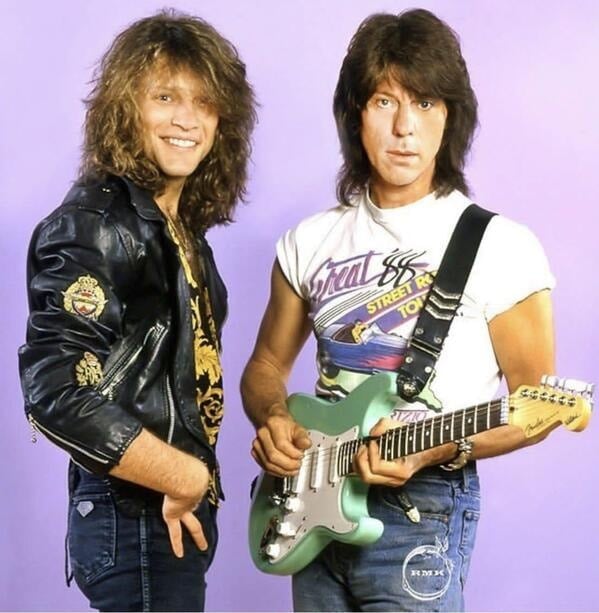
Picture from the photo session made for the October 1990 issue of Guitar magazine featuring Jeff with John Bon Jovi.
The green Strat featured the roller nut and the signature on the headstock, but was devoid of the dual Lace Sensor at the bridge and the push/pull switch. Is it the green prototype made by J. Black?
|
Paradoxically, when the first Jeff Beck Stratocasters came out, the Graffiti Yellow finish was not taken into consideration, and the signature was available only in Midnight Purple, Surf Green and Vintage White. And the first Strats Plus Graffiti Yellow, unlike what many believe, were not Jeff Beck prototypes!
It is interesting to note that pau ferro was chosen for the fretboard. However, almost immediately, Fender opted for rosewood, though many ‘90s Frontlines continued to report it as pau ferro.
It is interesting to note that pau ferro was chosen for the fretboard. However, almost immediately, Fender opted for rosewood, though many ‘90s Frontlines continued to report it as pau ferro.
The Jeff Beck Second Series
In 2001 this signature was renewed by Fender. The second series, available in the Olympic White and Surf Green finishes, featured three Ceramic Coil Dual Noiseless pickups instead of Lace Sensors, a thinner “C”-shaped neck, not as large or deep as Jeff’s previous choice, a sculpted heel for easier access to the higher registers, and a classic tone control instead of the TBX used in the first series.
The Custom Shop Model
Finally, in 2004, the Custom Shop unveiled the Jeff Beck Signature Stratocaster, available in Olympic White and Surf Green, which distinguished itself because the signature was not put on the front of the headstock, but on the back, and for the Sperzel Trim-Lok Staggered tuning machines.
End note: in May 2023 the original yellow strat was sold at Bonham's auction house for £76,600.
End note: in May 2023 the original yellow strat was sold at Bonham's auction house for £76,600.
Antonio Calvosa
